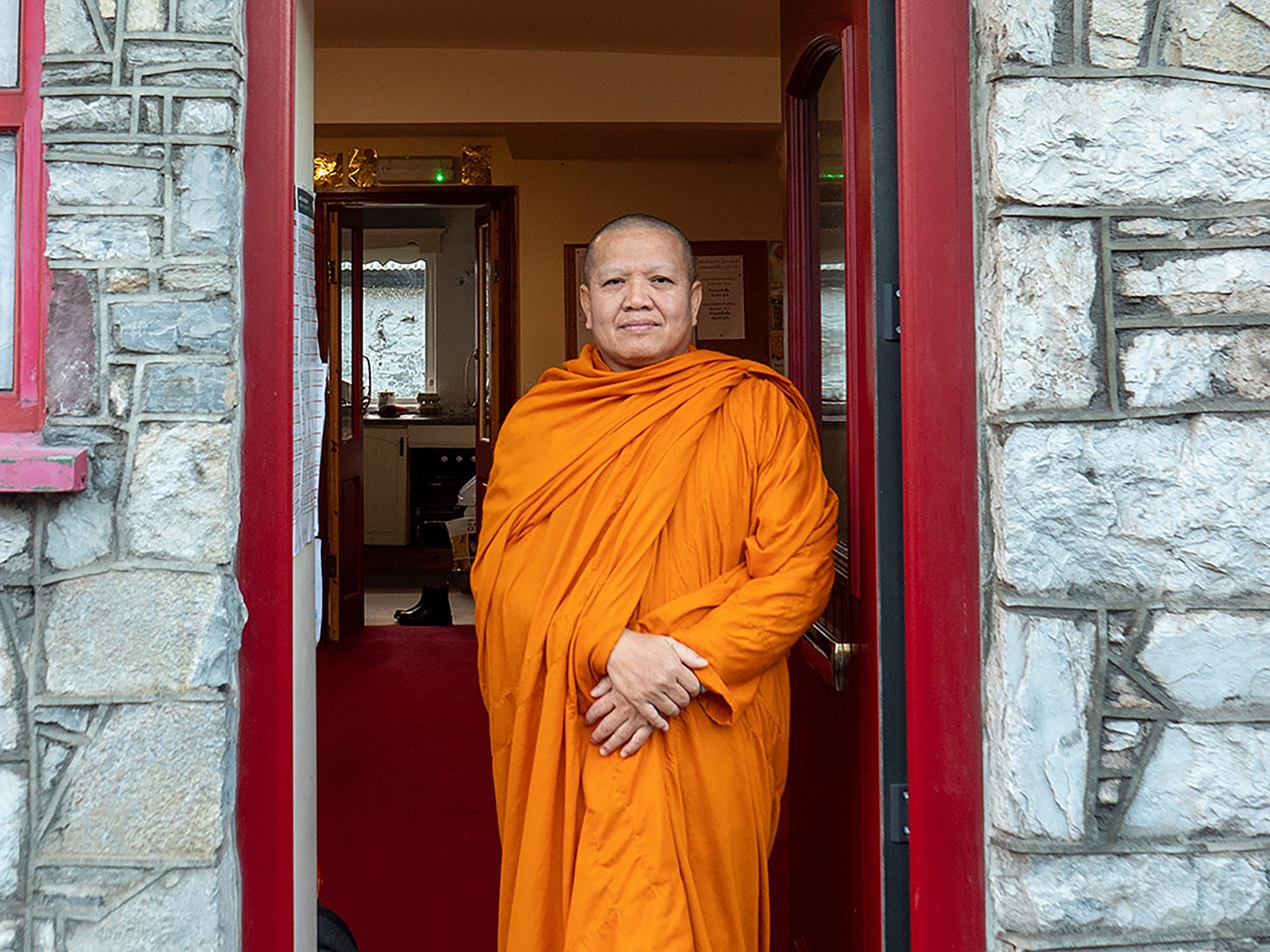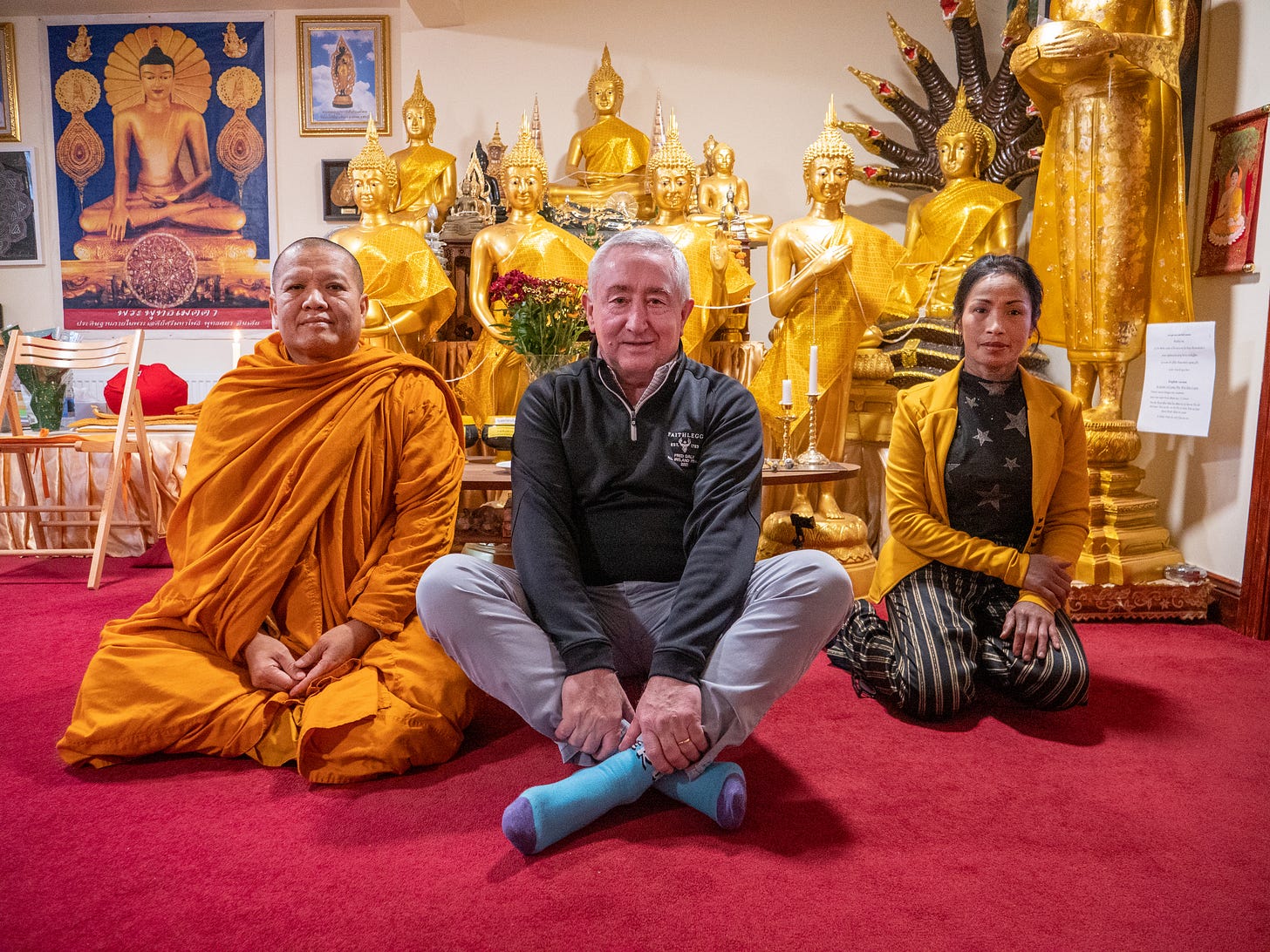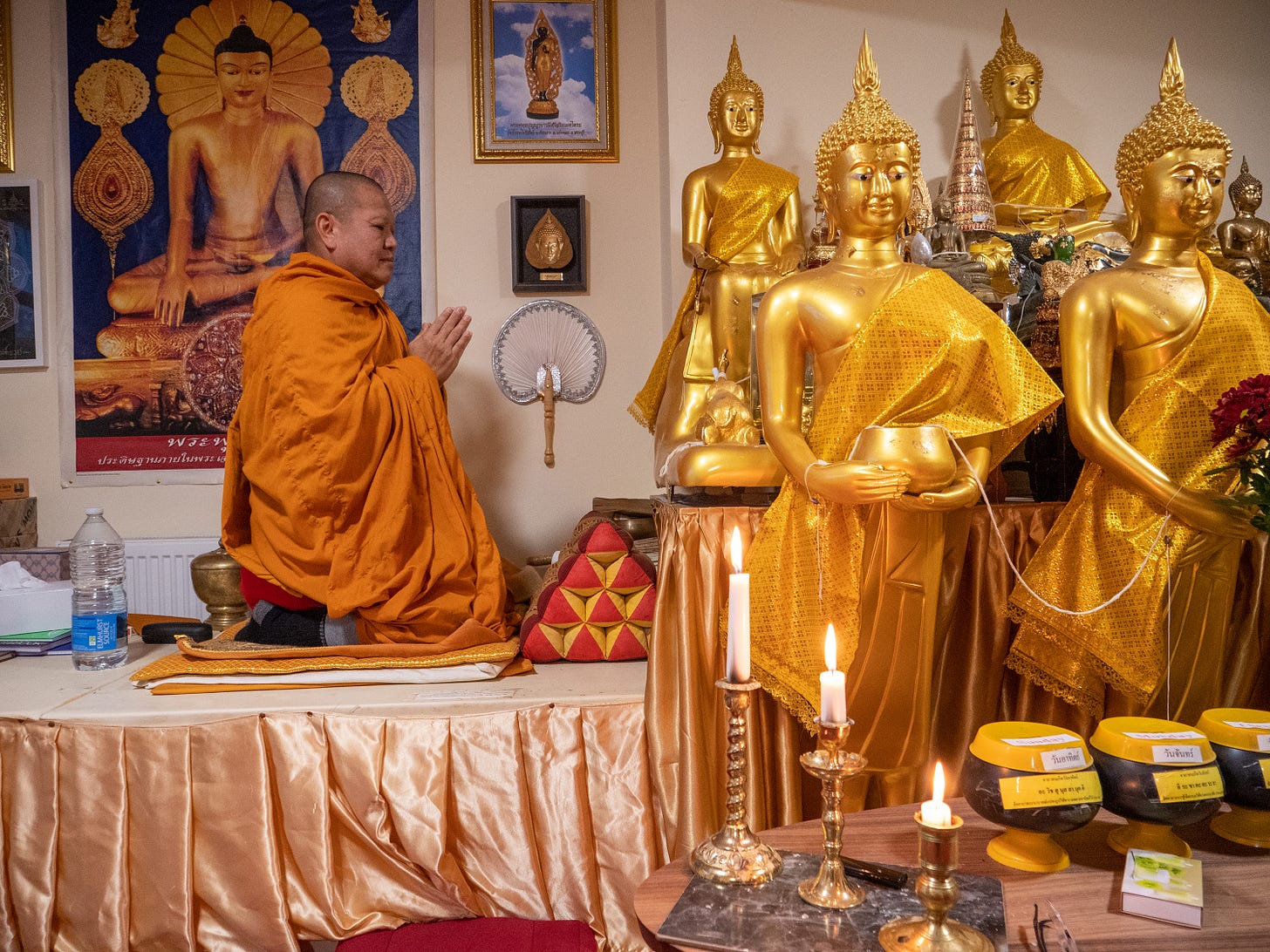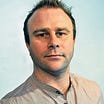The monk of Mitchelstown
In North Cork, a small grey stone house is home to a colourful place of worship: Ireland's only Thai Buddhist temple and Phra Maha, the orange-robed monk who founded it.
At a temple in Mitchelstown
Above the door of a gray, stone-clad building on Mitchelstown’s Upper Cork St, a sign reads Wat BuddhaMahadhtu.
It means “The Lord Buddha lives in the Big Pagoda.” It says the same thing in the Pali language above that.
Given the building’s classic Irish townhouse appearance, passersby might not guess that this is a Theravada Buddhist temple.
Wat BuddhaMahadhtu draws people from all walks of life. It serves as a refuge for Thai people living in Ireland, who are devotees of Buddhism, while offering a community for anyone wishing to develop their meditation practice, or to learn about Buddhism in general.
There might be one giveaway that there is a big Pagoda somewhere in town. The building doubles as a home for Phra Maha Rumpai Kaenkul, a Thai Buddhist monk who set up the temple in 2018.
He is regularly seen going about his daily business in Mitchelstown wearing his orange Saffron robes.
Phra Maha knows I’m visiting him today and our meeting is arranged through a Temple volunteer.
He beckons me to come in.
Locals, he says, are very kind to him.
“When I walk down the street, they all wave their hand to me,” he says fondly. “Before, I was shy when I walked in Mitchelstown, but now, I want to know everyone. I can’t help but know that I am accepted here.”
The downstairs floor is where Buddhist devotees gather. It is a bright, open-plan room, resembling the living area of similar looking townhouses. To the right there is a table placed beneath a staircase that leads to Phra Maha’s living area.
He invites me to sit and offers tea.
Directly across is the shrine. An assortment of tall gold statues of Buddhist figures stand beneath framed iconography on the wall. Facing the statues, there is a rise where Phra Maha sits in devotion, praying, chanting and meditating.
“Every morning and evening I am there,” he tells me.
Sitting down with him, he comes across as calm, and supple of mind. He is very open, happy that I’m here.
Phra Maha is also called Phra Ajahn. Phra means monk, Ajahn means master and Maha is the name given to a monk who has mastered the Pali language. His own personal first name is Rumpai, so he is sometimes called Phra Maha Rumpai.
It was in the Wat Pandhuis Monastery in the Muang district of North East Thailand he was ordained as a monk. His family had a strong Buddhist faith, and he tells me that was “glad and excited” on ordination day. He was 21 years old.
In 2011 the relatively small but growing Thai Buddhist population in Ireland still lacked a temple and an Ajahn. That same year, by way of their invitation, Phra Maha came to Ireland to fill the role.
“They wanted to set up a temple in Ireland, because the Thai community wanted to have a Thai temple. Before that I stayed in England, and after that I set up a Buddhist charity.”
Funds donated to the charity came from members of the Thai community living in Ireland as well those living in Thailand. And when enough funds were donated, he bought the property in Mitchelstown where the temple is now located.
The peace of the Irish countryside
Why Mitchelstown? Why not Dublin or Cork? Or any other location with a wider demographic?
“When I first arrived in Ireland, I lived in Waterford, then I moved to Cork,” he says. “In Dublin there is the big city, with many Thai people. But I think it's not fit for me.” Phra Ajahn says he prefers to live in the forest, the Irish countryside, “for peace.”
Before settling in Mitchelstown in 2018, he had lived in Ballyhooly and Blarney. Both locations acted as temporary temples where devotees came to meditate.
Phra Maha has developed mutually supportive friendships with locals who volunteer their time at the temple. During our chat, there are two such volunteers present. Both however, wish to remain anonymous, but both say they like to support the temple and Phra Maha in any way they can.
“I really like the innocence of the monastics,” one volunteer tells me. “I started coming here to learn meditation. In return, I wanted to give something back, so I started to help Phra Ajahn with English lessons.” Another volunteer says they “like to engage people with the teachings of the Buddha, to engage people with meditation and to support the temple.”
Each morning and evening, Phra Maha sits chanting over a Facebook Live broadcast. In the mornings, people can tune in to listen, or stay online to join in meditation. In the evenings, after chanting is completed, locals are welcome to join him and sit with him in person.
The Thai and Sri Lankan communities
During Buddhist calendar events such as Kathina, Bodhi Day and Vesak, the temple welcomes members of the Thai community and members of the public who wish to come and celebrate.
“People from Thailand take turns visiting,” Phra Ajahn says. “Last week there were six. But next week there is more, and week after there is more and so on. They come from all over Ireland, from Kildare, from Dublin, from Limerick. This place is important for Thai people, because it is the only Thai temple in the country.”
Other communities to avail of the Temple are the members of the Sri Lankan Buddhist community who are based nearby, in Mallow. “They will come for celebrations and bring food,” he says.
Waterford couple Jim Comerford and his wife, Kingkarn Suwansing, from Northern Thailand, are regular visitors to the temple. They’re here to support Phra Maha in his interview, and help clarify anything that may get lost in translation between us as we chat.
“Myself and Phra Ajahn are friends now at this stage,” Jim says. “We text each other and everything. He’s more like a friend than a monk.”
Kingkarn says going to temple helps her think about her family and connect to her life at home: “We like to bring food and be here for meditation.”
Jim believes what Phra Ajahn has created in Mitchelstown is imperative for Thai nationals, saying the temple is “a focal point. I’m not the most religious person, but you can fall into the culture. I really see how my wife and people from her community get a lot out of visiting here and people like myself who aren’t very religious like to have alternatives,” he says, referring to Ireland's dwindling numbers of Church goers.
While the temple in its current guise meets the needs of those seeking what it offers, it’s quite the small space and Phra Maha has plans to expand.
The combined townhouse and temple sits on roughly half an acre. To the rear of the site, Phra Maha has plans to build a bigger temple. He wishes to provide more space for devotees and for novices being introduced to Buddhism and meditation, and overnight accommodation for anyone wanting a few days to practice. His expectation is that it will cost close to €200,000 to complete and that funds will be raised through donations.
From the outset, Wat BuddhaMahadhtu generally appears to be more oriented towards Thai people. According to the 2016 census there are roughly 10,000 Buddhists in Ireland. How many of the 10,000 are from Thailand is not clear.
Despite the relatively small numbers of Buddhists in Ireland, Buddhism, in its varying forms, seems to appeal to a much wider demographic than appears on paper.
Professor of Sociology at Maynooth University, Laurence Cox, has been researching Buddhism in Ireland for fourteen years. He believes that while there are many more Irish people who lean towards Buddhism, when they are asked ‘what’s your religion?’ on census forms, they usually answer from the perspective of tradition, based on what church their parents went to or whether they were baptised Catholic or christened in the Protestant faith.
The different forms of Buddhism in Ireland
Not unlike Christianity, Buddhism comes in different forms. In Ireland the most popular forms of Buddhism are Theravada, Zen and Tibetan. Theravada is largely practiced in the countries of South East Asia: Myanmar, Thailand, Laos and Vietnam. It’s focus is on the teachings of the Eightfold Path and the Four Foundations.
Zen Buddhism has origins in China, Japan and Korea, and focuses on sitting meditation and attaining peace through effortless action. Tibetan Buddhism which has a focus on a teacher or ‘lama’ and utilises mantra and meditation.
In May of this year, Zen Buddhism Ireland opened its doors in Temple Bar in Dublin. They are based in the heart of the city and offer morning and evening sitting practice.
Sunyata Buddhist Centre in Co Clare has a particular focus on the Theravada lineage, however, it is open to people of any faith and will host a range of retreats there across its annual calendar of events.
Dzogchen Beara in West Cork is a Tibetan Buddhist Centre perched on Beara Peninsula. It is perhaps the most well known such centre in Ireland and is presently building a large scale temple on its site. It will be the only Tibetan Buddhist temple in the country, and with a three layered copper roof, it will certainly be a rare sight to behold. It is estimated that the temple will open its doors in 2024.
Common across the traditions are their uses of mindfulness and meditation.
“What we call mindfulness is unequivocally and very explicitly derived from Buddhism and its derived primarily Theravada meditation practices,” Laurence explains.
In the late 19th and early 20th centuries, these practices were developed in a way that would make them accessible to lay people, and not simply to full-time monastics. This began in Asia, and it was in the second half of the twentieth century that these practices became common in western countries.
Buddhism as the origin of modern “mindfulness”
By the late 1970s, John Kabat-Zinn founded what we know today as Mindfulness Based Stress Reduction (MBSR), a secularised approach to meditation for stress reduction. He removed any references to Buddhism as a religious practice, while retaining the practices that had demonstrated positive effects for the human psyche.
Laurence believes that these days the word ‘mindfulness’ can be put in front of anything for the purposes of selling something: “There is a lot to be said for looking for mindfulness training that is coming from people who are experienced, who are operating within a community of practitioners, whether that's Buddhist or therapists, who are accountable, it's generally good advice.”
While Dzogchen Beara, Sunyata and others are carrying their messages to growing numbers of Irish practitioners, where Wat BuddhaMahadhtu stands out is as the only temple in Ireland whose founders are indigenous to a Buddhist country.
“It’s unusual and praiseworthy to have a Buddhist centre which is primarily run by people from a Buddhist country because most Buddhist centres, in Ireland in particular, are run by western Buddhist converts,” Laurence says.
Back in North Cork at Wat BuddhaMahadhtu, Phra Maha’s Buddhist practice is as evident as ever when he’s asked what his hopes and plans are for the future of the Mitchelstown temple.
“I don’t hope for anything,” he says. “Just chanting and meditating, every day.”
And how about the new temple, when construction begin?
“When I am ready to construct the temple,” he says with a big smile.









